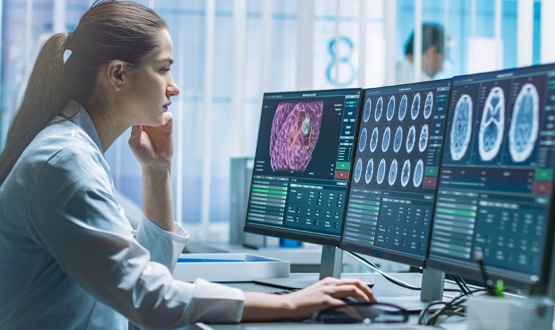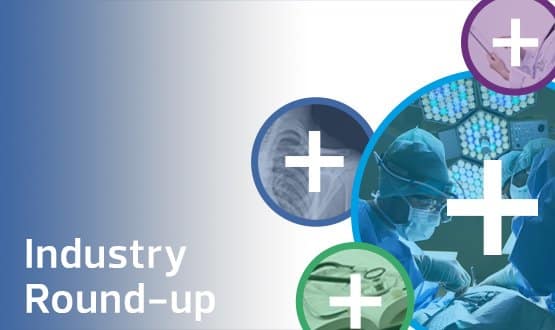Special Report: Imaging
- 21 June 2023


Special Report: Imaging

The regionalisation of NHS imaging services facilitated by the cloud is a promising stepping stone towards more integrated care. AI’s potential, however, is taking longer than expected to be fulfilled. By Owen Hughes
It’s difficult to talk about digital transformation without mentioning the cloud, particularly when referring to large-scale IT initiatives that involve the sharing, sorting and storing of large sets of data.
It is of little surprise, then, that the NHS’s late but steady adoption of public cloud has been widely welcomed by those leading efforts to modernise NHS imaging services and introduce more integrated ways of working across regions and disciplines.
The Greater Manchester (GM) Imaging Network was established in 2020 with the aim of improving access to diagnostics services and speeding up diagnoses through a region-wide imaging strategy.
Comprised of eight NHS hospital trusts serving a combined population of 2.822 million, the network represents one of the largest imaging networks in Europe and allows radiologists and diagnosticians to more easily access and report on patient images captured at any hospital in Greater Manchester.
A central component of the initiative is a cloud-hosted picture archiving and communication system (PACS) provided by Sectra, alongside a vendor neutral archive (VNA).
Katie Moss, programme director of the GM Imaging and Pathology Networks – the latter representing a similar regional initiative for digital pathology – says the centralised PACS has had a significant impact on turnaround times for diagnostics by enabling instantaneous, cross-boundary reporting. This is something that has never before been possible.
“The PACS solution is essentially helping us to share images across the network so that we can have reporting done, essentially, anywhere in the world,” Moss explains.
“Clinicians are absolutely reaping the benefits of these systems because it’s speeding up efficiency. It’s leading to quicker turnaround times for diagnostics, because we’re not, for example, having to wait for scans to be sent from site to site if a patient accesses services across Greater Manchester. It’s having a massive impact for us.”
The shift to regionalisation
Greater Manchester represents one of a growing number of region-wide initiatives aimed at promoting standardisation and data-sharing in diagnostics.
A similar initiative has been underway in Yorkshire since 2016 as part of the Yorkshire Imaging Collaborative (YIC), which also involves eight regional trusts joined by a unified PACS with the aim of achieving full integration of radiology workflows across the region.
Ray Cahill, vice president, international at Change Healthcare, notes that NHS trusts have been steadily transitioning from managing traditional PACS systems to cloud-based solutions in recent years, largely driven by the efficiency and cybersecurity advantages of cloud technology.
From a trust perspective, there are a number of factors that make managing a large PACS difficult, says Cahill, from the availability of IT resources to the constant need to upgrade platforms and, more recently, the need for digital tools that facilitate remote working. This makes an enterprise imaging strategy based on a shared system appealing.
“We’re seeing from all the tenders that are coming out that very few trusts are coming out of their own: they’re all coming out as collaborations and consortiums to try and get over that great problem and improve the way patient care is delivered,” says Cahill.
“The consortium can then store all of their images in a centralised platform, and that makes sharing so much easier. There’s no point having all of that data stuck in private data centres or stuck in hospital data centres, because it’s helping the local population, but it’s not supporting the greater good.”
Jane Rendall, managing director UK at Sectra, shares a similar sentiment.
“This is not a unique thing now in healthcare: we see the regionalisation of services happening more as a norm,” says Rendall.
“They really are looking to work in collaboration with others, not just to save money, but also to share resource and share expertise as well, [and to] further mature and develop their own digital maturity, but also the network maturity.”
The importance of feedback loops
Rendall notes that imaging and pathology networks such as those established in Greater Manchester also create the possibility of combining radiology, pathology and medical photography into a single, integrated diagnostics department that feeds back into the electronic patient record (EPR).
Rendall highlights the importance of feedback loops in an integrated system, which allow specialists to learn from each case and track the patient through their care journey.
“For example, if you’re a pathologist and you had an interesting case, you might never know what happened to that case unless you put a note on it saying: ‘Please let me know what happens with this patient’,” says Rendall.
“In other industries, you would always seek feedback loops so you would learn as an organisation. I think that when you start to work collaboratively, you’ve got the ability to build in those feedback loops, especially to the EPR [which] plays a huge part in information which can add value when you’re making a decision about clinical care.”
On the subject of integrated systems, Cahill discusses his own experience overseeing the implementation of Ireland’s National Integrated Medical Imaging System (NIMIS). NIMIS represents the largest single PACS/RIS imaging database in the world, supporting 58,000 users across 75 sites, and facilitating more than two petabytes – or 2,000,000 GB – of managed storage.
“I look at Ireland today, 12 years later, at the benefits around interoperability they’ve achieved by taking that bold step to go centralised, and the changes that it’s made to the patient care pathways,” says Cahill.
“In the past, hospitals would have taken hours to get the necessary information across for them to make a decision about whether a care decision was appropriate or not. Now it takes minutes. That’s real transformation.”
By comparison, the GM Imaging Network is still in early days, with Moss anticipating greater benefits later down the line with the deployment of PACS-based reporting, MRI accelerator technology, and deployment of the iRefer clinical decision support tool for radiologists.
A shared reporting tool presents a particularly compelling opportunity for the network, explains Moss, as it would allow radiologists, diagnosticians and other clinicians to report on medical cases and share their findings across Greater Manchester. It could also facilitate single-queue diagnostics, which could prove instrumental in bringing down growing diagnostic waiting times.
Irrespective of potential future benefits, Moss stresses that the shared PACS is already having a demonstrable impact on efficiency and flexibility across the network, particularly in the way it has standardised processes across member trusts.
“The standardisation across Greater Manchester with that system has just gone through the roof,” says Moss.
“Clinicians are now able to access that from any site so they can work around any site. They’re not having to open up new systems, they’re not having to learn anything extra. The movement of staff, then, is transferable from each organisation, in terms of the knowledge and their experience with the system.”
AI and imaging
There’s another benefit to large, shared image databases hosted in the cloud: the potential for the application of artificial intelligence (AI).
Rendall believes AI will play a crucial role in population health and precision medicine initiatives by enabling NHS organisations to structure, process and understand vast volumes of data held in shared databases.
That said, she does advise tempering expectations, at least in the short-term. “We always underestimate the long-term benefits of things like that. When we estimate what’s going to happen, we always imagine it’s going to be amazing tomorrow,” says Rendall.
“I think, fundamental to [AI’s] success, will be the structured reporting: how we can structure the data that we’re delivering in a way that makes it extremely valuable when it’s consumed in the future. So structured data, I think, is a fundamental pillar.”
Moss is also enthusiastic about the potential future application of AI tools within the Greater Manchester Imaging Network.
Specifically, Moss discusses the potential standardisation and integration of AI into clinical pathways, which could aid clinical reporters in diagnostic triaging and improve predictive measurements that would allow clinicians to prioritise high-risk patients.
“We can turn around diagnostics a lot quicker, because we can use AI to triage and do those elements of reporting that really improve the predictive measurements, combining medical images with other clinical information,” Moss adds.
“We’re definitely looking at triaging and reporting with the introduction of AI.”
Cahill, while acknowledging the potential of AI, stresses the need for NHS organisations to first consolidate and analyse their current data before jumping into complex AI solutions.
“What’s interesting about AI is that it has taken off in some areas, but it hasn’t taken off as fast as people would have thought five years ago,” he says.
“There’s so much data out there that will give you insight; that’s the thing we need to look at first. AI is really good but if you don’t look at the data that’s right in front of your face, and leverage those insights to affect change, we’re missing a big trick.”




